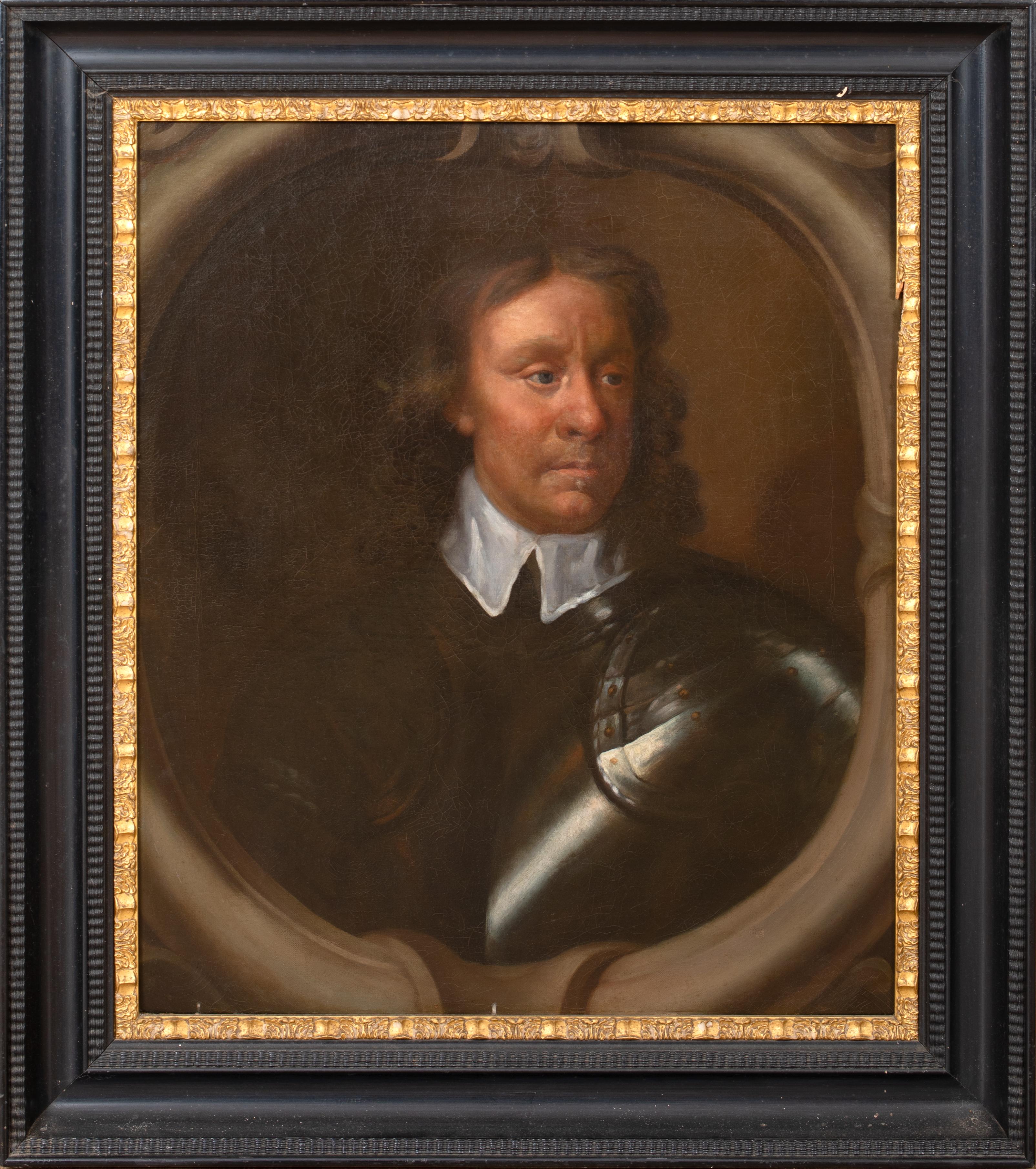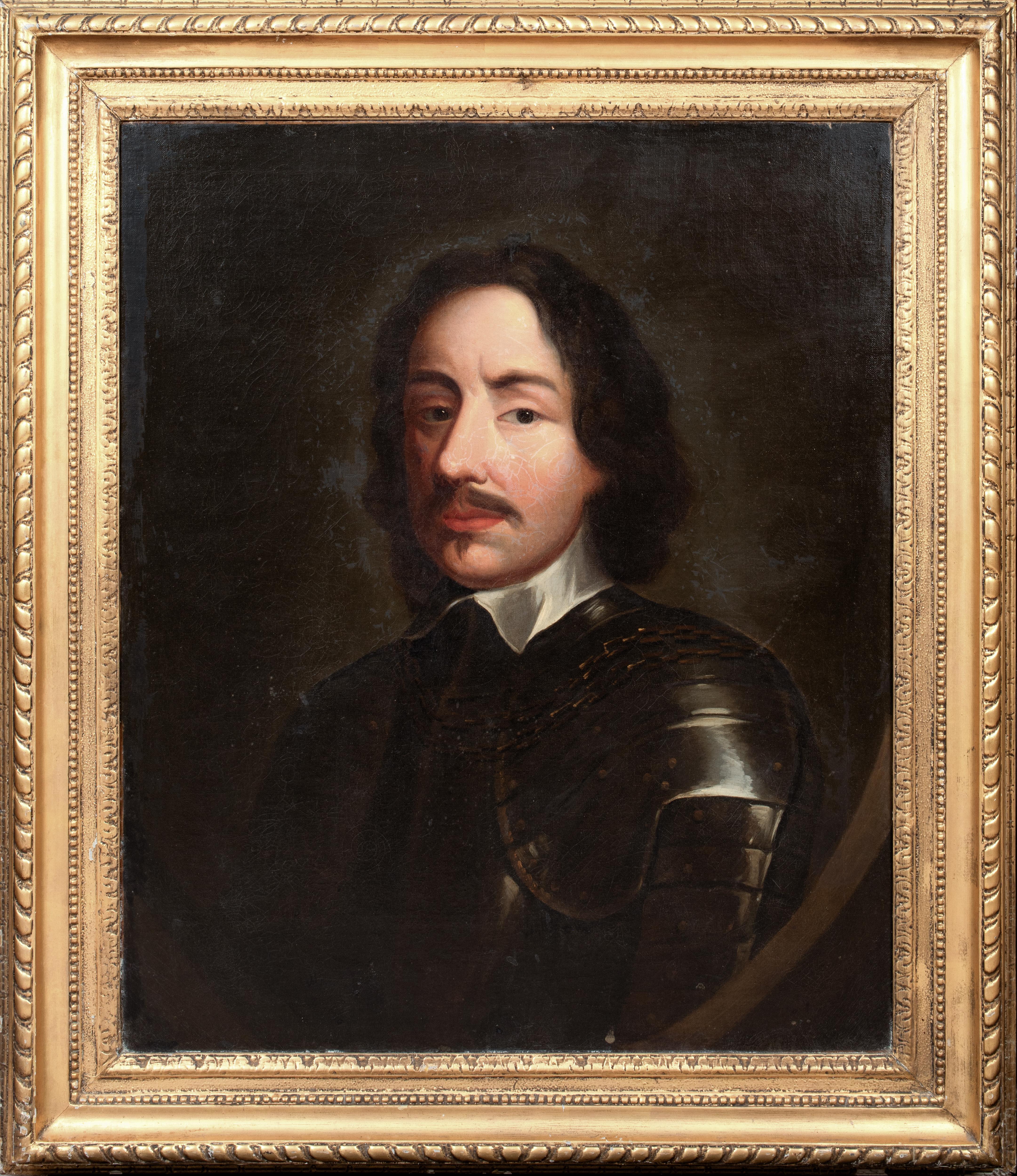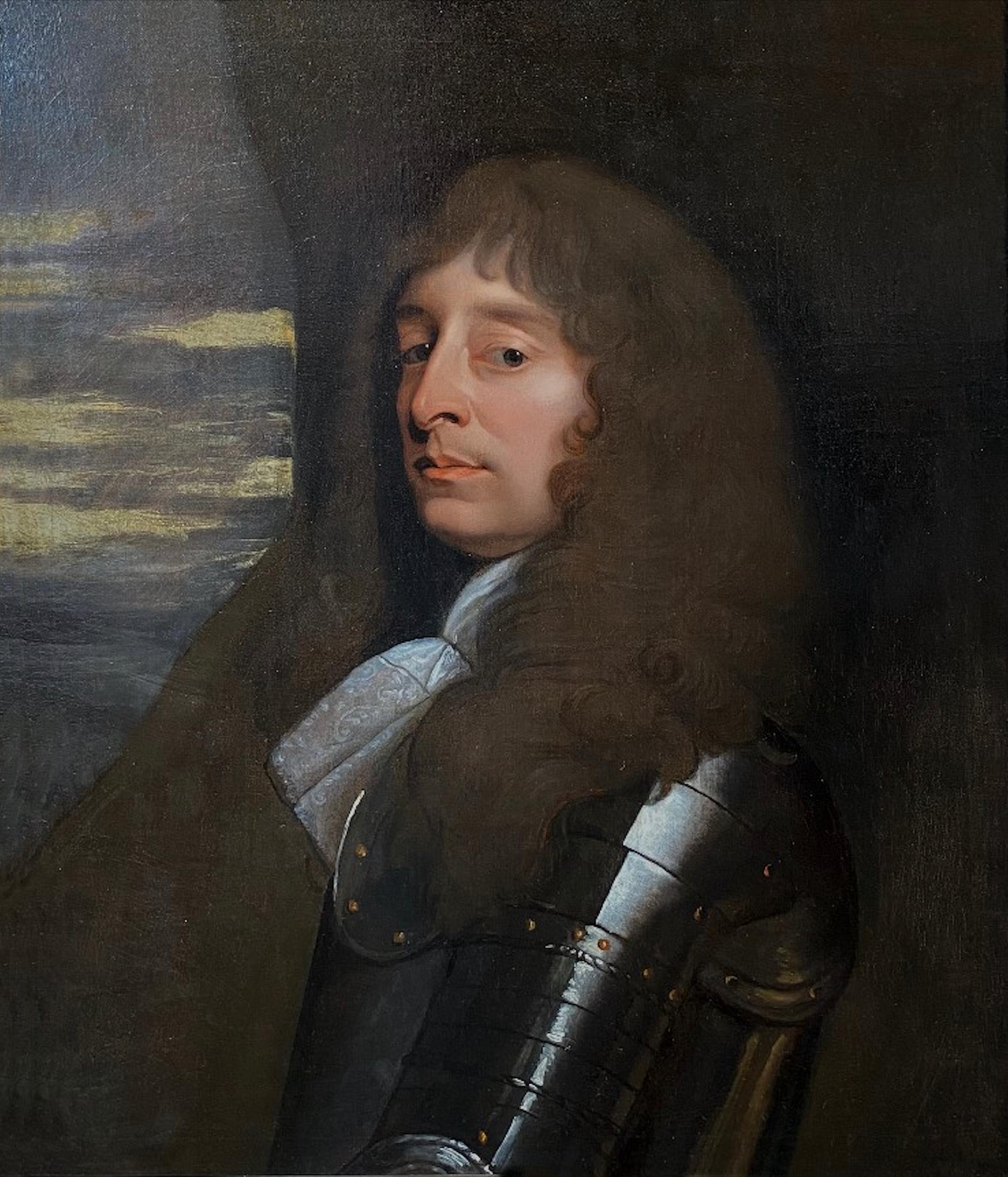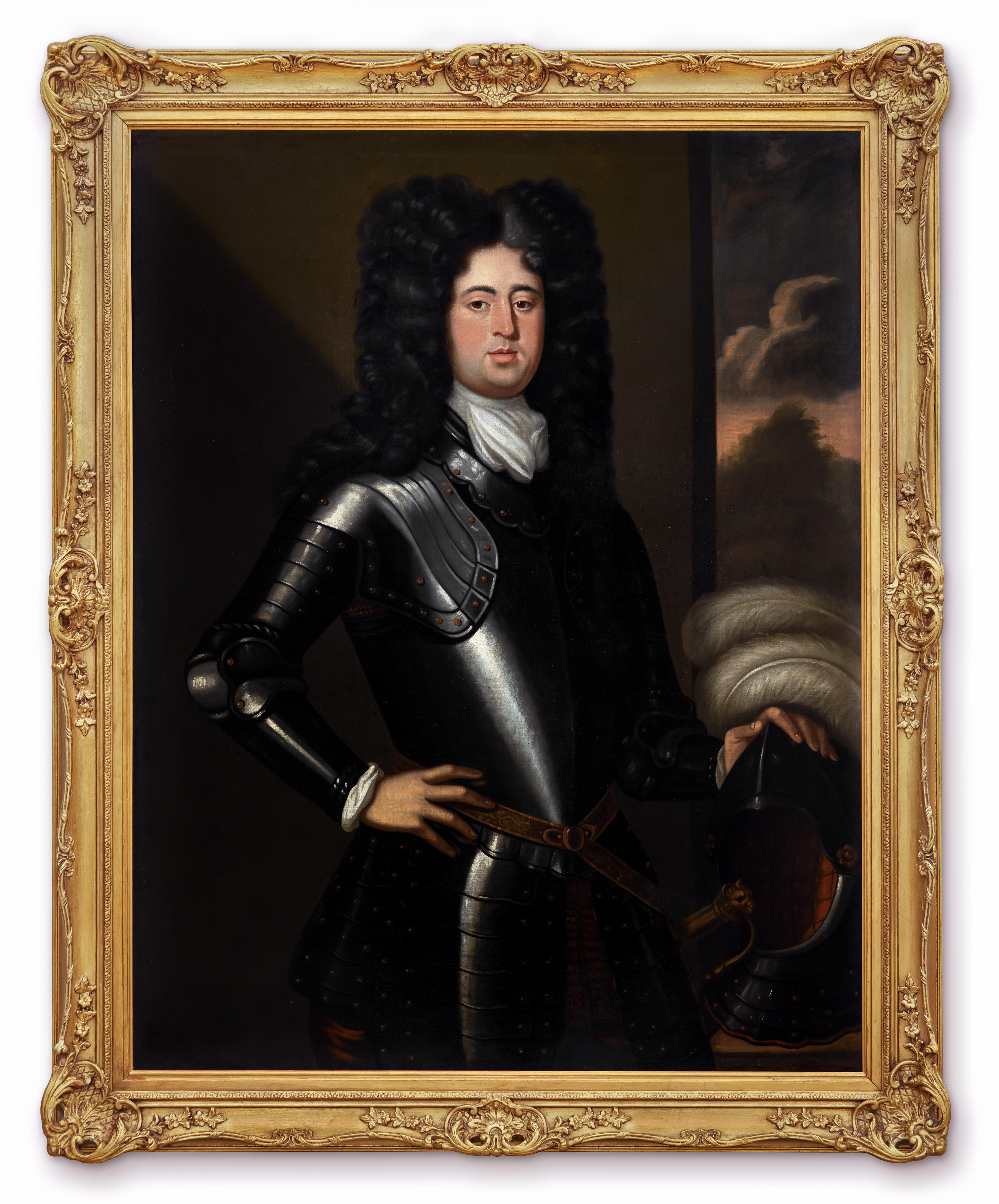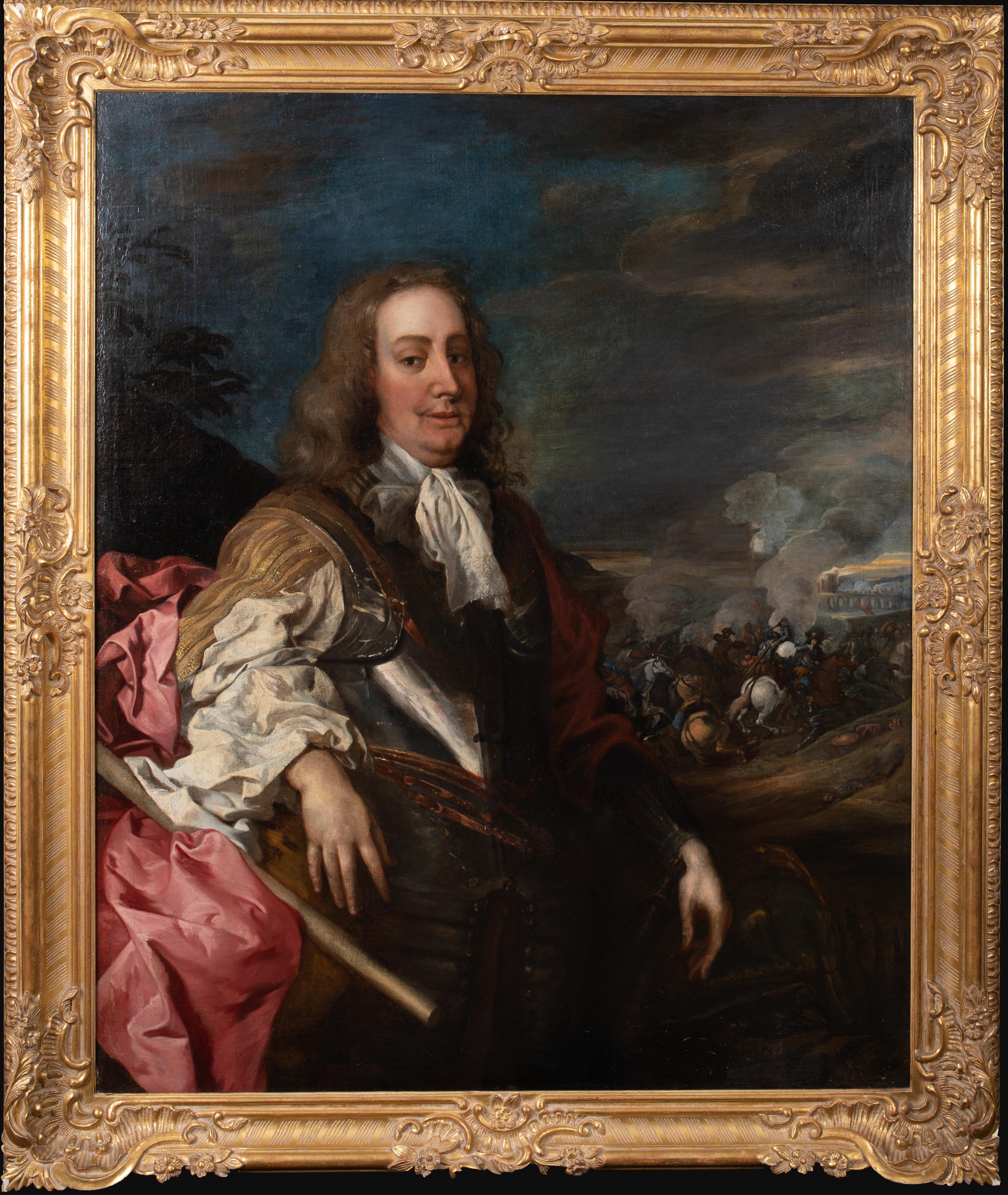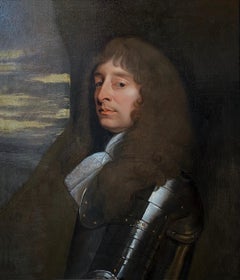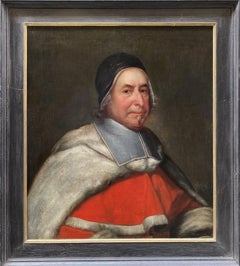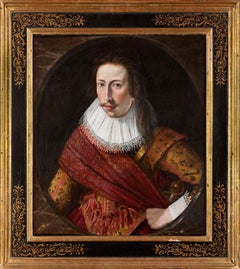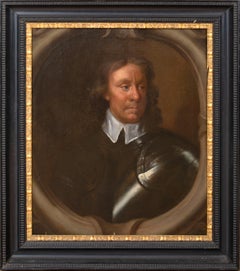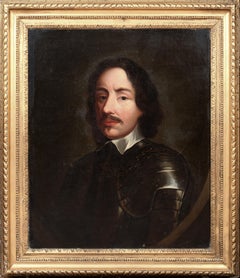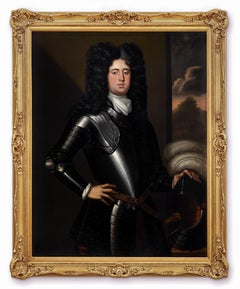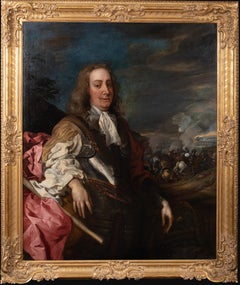Items Similar to Portrait of Oliver Cromwell (1599-1658), bust-length, in armour
Want more images or videos?
Request additional images or videos from the seller
1 of 5
Portrait of Oliver Cromwell (1599-1658), bust-length, in armour
$17,034.92
£12,350
€14,532.44
CA$23,573.77
A$26,247.95
CHF 13,658.92
MX$316,807.78
NOK 171,295.49
SEK 161,799.38
DKK 108,495.41
About the Item
After Robert Walker
1599 - 1658
Portrait of Oliver Cromwell (1599-1658), bust-length, in armour
Oil on canvas
Image size: 24 x 29 inches (61 x 73 cm)
Original carved gilt frame
This unfinished portrait of Oliver Cromwell presents him in his battle armour, symbolising his role in the English Civil Wars. Born in 1599, Cromwell was a prominent English soldier and statesman who led the parliamentary forces during the Civil Wars and served as Lord Protector of England, Scotland, and Ireland from 1653 to 1658.
As a key general for the parliamentary side against King Charles I, Cromwell played a crucial role in the downfall of the Stuart monarchy. His leadership as Lord Protector restored England’s status as a leading European power, a position it had lost after Queen Elizabeth I’s death.
Cromwell’s military successes both domestically and internationally fostered a Puritan mindset that influenced political and social life in Great Britain and North America for many years. As a descendant of Thomas Cromwell, Henry VIII’s chief minister, on his father’s side, Cromwell’s family gained a lot of land from their relationship to the monarchy and while it was noted that he was not opposed to Charles I he created an atmosphere of distrust in his army of parliament and the crown to introduce a more democratic constitution that led to the two English Civil Wars.
In Parliament, Cromwell was known for his fervent religious views and advocacy for radical reforms, which eventually led to his marginalisation by opposition leaders during the early months of the Long Parliament.
Before convening his first Protectorate Parliament on September 3, 1654, Cromwell and his Council of State enacted over 80 ordinances that reflected a progressive domestic agenda. His goals included legal reform, establishing a Puritan Church with tolerance for other denominations, promoting education, and decentralising administrative functions.
Robert Walker
Robert Walker, born in 1599, was a prominent English portrait painter known for his significant contributions during the Commonwealth period. His artistic style was heavily influenced by Van Dyck, yet he developed a distinctive approach that set his work apart. Walker became the chief painter for the parliamentary party, capturing the likenesses of many key figures of the time. His most notable works include portraits of Oliver Cromwell, the Lord Protector, which have become iconic representations of Cromwell’s appearance. These portraits, often depicting Cromwell in armour, were widely reproduced and are considered some of the truest representations of him.
Robert Walker’s portraits of Oliver Cromwell often depicted him without the warts and facial hair that were known to be part of his appearance. This choice might have been influenced by the artistic conventions of the time, which often aimed to present subjects in a more idealised manner. Cromwell himself is famously quoted as having said to another artist, Sir Peter Lely, “paint me as I am, warts and all,” indicating his preference for a realistic portrayal. However, Walker’s portraits seem to have taken some artistic liberties, perhaps to emphasise Cromwell’s status.
Museums
National Portrait Gallery
Ashmolean Museum, Oxford
British Museum
Chepstow Museum, Wales
Walker Art Gallery, Liverpool
Fitzwilliam Museum, Cambridge
The Courtauld Gallery
The National Trust Collection
The Royal Collection
- Dimensions:Height: 29 in (73.66 cm)Width: 24 in (60.96 cm)
- More Editions & Sizes:24 x 29 Price: $18,720
- Medium:
- Movement & Style:
- After:Robert Walker (1942, American)
- Period:
- Condition:
- Gallery Location:London, GB
- Reference Number:1stDibs: LU52415177932
About the Seller
5.0
Vetted Professional Seller
Every seller passes strict standards for authenticity and reliability
Established in 2007
1stDibs seller since 2014
82 sales on 1stDibs
Typical response time: 4 hours
- ShippingRetrieving quote...Shipping from: London, United Kingdom
- Return Policy
Authenticity Guarantee
In the unlikely event there’s an issue with an item’s authenticity, contact us within 1 year for a full refund. DetailsMoney-Back Guarantee
If your item is not as described, is damaged in transit, or does not arrive, contact us within 7 days for a full refund. Details24-Hour Cancellation
You have a 24-hour grace period in which to reconsider your purchase, with no questions asked.Vetted Professional Sellers
Our world-class sellers must adhere to strict standards for service and quality, maintaining the integrity of our listings.Price-Match Guarantee
If you find that a seller listed the same item for a lower price elsewhere, we’ll match it.Trusted Global Delivery
Our best-in-class carrier network provides specialized shipping options worldwide, including custom delivery.More From This Seller
View AllPortrait of a Nobleman in Armour, 17th Century Oil Painting
By Anthony van Dyck
Located in London, GB
Oil on canvas
Image size: 30 x 35 inches (76.25 x 89 cm)
Carved gilt frame
A half-length portrait of a man turned slightly to the left, gazing at the spectator, standing, wearing st...
Category
17th Century Portrait Paintings
Materials
Canvas, Oil
Portrait of a Gentleman, 17th Century Dutch Old Masters Oil
Located in London, GB
Circle of Gerard van Honthorst
1592 - 1656
Portrait of a Gentleman
Oil on wooden panel
Image size: 29 x 23 inches
Contemporary gilt frame
Gerard van Honthorst was a Dutch Golden Age...
Category
17th Century Old Masters Portrait Paintings
Materials
Oil, Wood Panel
Portrait of a Judge, 17th Century English Oil Portrait Painting
Located in London, GB
Oil on canvas, on board
Image size: 30 1/4 x 27 inches (76.75 x 68.5 cm)
Contemporary style handmade frame
This is a attention-holding portrait of a 17th century English judge...
Category
17th Century English School Portrait Paintings
Materials
Oil, Board
Portrait of an Officer, Cornelius Johnson, 17th Century Old Masters
By Cornelius Johnson
Located in London, GB
Circle of Cornelius Johnson
Circa 1620’s
Portrait of a Officer
Oil on canvas
Image size: 28 x 24 inches
Period style hand made frame
Provenance
Private European Estate
This striking portrait dates to around 1620, as you can see from the images of the sash the detail is very high. The sash is decorated with gold thread and would have cost a small fortune at the time. Sashes were originally developed for a military function (making officers more visible for their men during combat), but soon became a primarily male fashion...
Category
Early 17th Century Old Masters Portrait Paintings
Materials
Oil
Portrait of William Herbert, 3rd Earl of Pembroke, Early 17th Century Portrait
Located in London, GB
English School, (circa 1600)
Portrait of William Herbert, 3rd Earl of Pembroke
Oil on panel, oval
Image size: 29¼ x 23⅞ inches
Painted wooden frame
Provenance:
176, Collection of Francis Greville, 1st Earl of Warwick.
The Trustees of the Lord Brooks’ Settlement, (removed from Warwick Castle).
Sotheby’s, London, 22nd March 1968, lot 81.
Painted onto wooden panel, this portrait shows a dark haired gentleman in profile sporting an open white shirt. On top of this garments is a richly detailed black cloak, decorated with gold thread and lined with a sumptuous crimson lining. With the red silk inside it’s all very expensive and would fall under sumptuary laws – so this is a nobleman of high degree.
It’s melancholic air conforms to the contemporary popularity of this very human condition, evident in fashionable poetry and music of the period. In comparison to our own modern prejudices, melancholy was associated with creativity in this period.
This portrait appeared in the earliest described list of pictures of Warwick castle dating to 1762. Compiled by collector and antiquary Sir William Musgrave ‘taken from the information of Lord & Lady Warwick’ (Add. MSS, 5726 fol. 3) is described;
‘8. Earl of Essex – an original by Zuccharo – seen in profile with black hair. Holding a black robe across his breast with his right hand.’
As tempting as it is to imagine that this is a portrait of Robert Devereux, the 2nd Earl Essex, we might take this with a pinch of salt. Its identification with this romantic and fatal Elizabethan might well have been an attempt to add romance to Warwick Castle’s walls. It doesn’t correspond all that well with Essex’s portraits around 1600 after his return from Cadiz. Notably, this picture was presumably hung not too far away from the castle’s two portraits of Queen Elizabeth I. The first, and undoubtedly the best, being the exquisite coronation portrait that was sold by Lord Brooke in the late 1970s and now hangs in the National Portrait Gallery. The second, described as being ‘a copy from the original at Ld Hydes’, has yet to resurface.
The portrait eventually ended up being hung in the State Bedroom of Warwick Castle.
Archival documents present one other interesting candidate. The Greville family’s earliest inventory of paintings, made in 1630 at their home Brooke House in Holborn, London, describes five portraits of identified figures. All five belonged to the courtier, politician and poet Sir Fulke Greville (1554-1628), 1st Baron Brooke, and were hung in the ‘Gallerie’ of Brooke House behind yellow curtains. One of them was described as being of ‘Lord of Pembrooke’, which is likely to have been William Herbert (1580-1630), 3rd Earl of Pembroke. William was the eldest son of Greville’s best friend’s sister Mary Sidney, and was brought up in the particularly literary and poetically orientated household which his mother had supported. Notably, the 3rd Earl was one of the figures that Shakespeare’s first folio was dedicated to in 1623.
The melancholic air to the portrait corresponds to William’s own pretensions as a learned and poetic figure. The richness of the robe in the painting, sporting golden thread and a spotted black fabric, is indicative of wealth beyond that of a simple poet or actor. The portrait’s dating to around the year 1600 might have coincided with William’s father death and his own rise to the Pembroke Earldom. This period of his life too was imbued with personal sadness, as an illicit affair with a Mary Fitton had resulted in a pregnancy and eventual banishment by Elizabeth I to Wilton after a short spell in Fleet Prison. His illegitimate son died shortly after being born. Despite being a close follower of the Earl of Essex, William had side-stepped supporting Devereux in the fatal uprising against the Queen and eventually regained favour at the court of the next monarch James I.
His linen shirt is edged with a delicate border of lace and his black cloak is lined on the inside with sumptuous scarlet and richly decorated on the outside with gold braid and a pattern of embroidered black spots.
Despite the richness of his clothes, William Herbert has been presented in a dishevelled state of semi-undress, his shirt unlaced far down his chest with the ties lying limply over his hand, indicating that he is in a state of distracted detachment. It has been suggested that the fashion for melancholy was rooted in an increase in self-consciousness and introspective reflection during the late 16th and early 17th centuries.
In contemporary literature melancholy was said to be caused by a plenitude of the melancholy humor, one of the four vital humors, which were thought to regulate the functions of the body. An abundance of the melancholia humor was associated with a heightened creativity and intellectual ability and hence melancholy was linked to the notion of genius, as reflected in the work of the Oxford scholar Robert Burton, who in his work ‘The Anatomy of Melancholy’, described the Malcontent as ‘of all others [the]… most witty, [who] causeth many times divine ravishment, and a kind of enthusiamus… which stirreth them up to be excellent Philosophers, Poets and Prophets.’ (R. Burton, The Anatomy of Melancholy, London, 1621 in R. Strong, ‘Elizabethan Malady: Melancholy in Elizabethan and Jacobean Portraits’, Apollo, LXXIX, 1964).
Melancholy was viewed as a highly fashionable affliction under Elizabeth I, and her successor James I, and a dejected demeanour was adopted by wealthy young men, often presenting themselves as scholars or despondent lovers, as reflected in the portraiture and literature from this period. Although the sitter in this portrait is, as yet, unidentified, it seems probable that he was a nobleman with literary or artistic ambitions, following in the same vain as such famous figures as the aristocratic poet and dramatist, Edward de Vere...
Category
Early 17th Century Old Masters Portrait Paintings
Materials
Oil, Wood Panel
Portrait of a Melancholic Gentleman, 17th century Oil Painting
Located in London, GB
English School
17th Century
Portrait of a Melancholic Gentleman
Oil on canvas
Image size: 25 x 29 1/4 inches (63.5 x 72.25 cm)
Hand made contemporary style frame
Provenance
South of England Estate
This is a striking 17th century half-portrait of a man. He sits with his body turned to the left and his head to the right. His left hand is held in front of him with thumb and finger together. He wears a loose white shirt that is opened low down onto chest while being closed at his neck with a black ribbon. An orange cloak has also been draped across his arms in a rather dramatic manner.
This choice of costume is immediately notable and must be compared to other portraits of this time of Elizabethan courtiers wearing slashed silk outfits with ostentatious finery and silver swords. Indeed, if one examines 17th century English...
Category
17th Century Portrait Paintings
Materials
Canvas, Oil
You May Also Like
Portrait of Oliver Cromwell (1599-1658), 17th century
By Robert Walker
Located in Blackwater, GB
Portrait of Oliver Cromwell (1599-1658), 17th century
circle of Robert WALKER (1599-1658)
Large 17th Century English Civil War portrait of Oliver ...
Category
17th Century Portrait Paintings
Materials
Oil, Canvas
Portrait of General Henry Ireton (1611-1651) Son In Law to Oliver Cromwell
By Robert Walker
Located in Blackwater, GB
Portrait of General Henry Ireton (1611-1651) Son In Law to Oliver Cromwell, 17th Century
attributed Robert WALKER (1607-1658)
Large 17th Century portrait of General Henry Ireton, oil on canvas. Excellent quality and condition Civil War portrait...
Category
17th Century Portrait Paintings
Materials
Oil, Canvas
Portrait of Gentleman in Armour by Table & Helmut c.1685 Aristocratic Provenance
By Johann Kerseboom
Located in London, GB
Portrait of a Gentleman in Armour beside a Table with Helmut c.1685
Follower or circle of Johann Kerseboom (d.1708)
This exquisite Grand Manner work, presented by Titan Fine Art, wa...
Category
17th Century Old Masters Portrait Paintings
Materials
Canvas, Oil
Portrait Of General George Monck, 1st Duke of Albermarle (1608-1670)
By Jacob Huysmans
Located in Blackwater, GB
Portrait Of General George Monck, 1st Duke of Albermarle (1608-1670), 17th Century
by Jacob Huysmans (1633-1696)
Huge 17th Century British Old Master portrait of General Monck, 1st...
Category
17th Century Portrait Paintings
Materials
Canvas, Oil
Portrait Thomas Wentworth, 1st Earl of Stafford (1593-1641), 17th Century
Located in Blackwater, GB
Portrait Thomas Wentworth, 1st Earl of Stafford (1593-1641), 17th Century
Circle of Anthonius VAN DYCK (1599-1641)
Fine 17th century English School Old Master portrait of Anthonius...
Category
19th Century Portrait Paintings
Materials
Canvas, Oil
Portrait Of Charles I Of England (1600-1649) Wearing The Order Of The Garter
By Anthony van Dyck
Located in Blackwater, GB
Portrait Of Charles I Of England (1600-1649) Wearing The Order Of The Garter, 17th Century
circle of Sir Antony VAN DYCK (1599-1641)
Large 17th Century English portrait of King Cha...
Category
17th Century Portrait Paintings
Materials
Canvas, Oil
More Ways To Browse
Military Portrait
Robert Thomas
Antique Walkers
Civil War Portrait
King Bust
The Puritan
Thomas Crown
Oliver Charles
Portrait Of Queen Elizabeth I
Peter Oliver
Paintings By Thomas King Original
Democratic Convention
Queen Elizabeth Bust
Bust Queen Elizabeth I
Puritan Oil Painting
Lord Nelson Painting
Steve Kaufman Marilyn
Christina Aguilera
